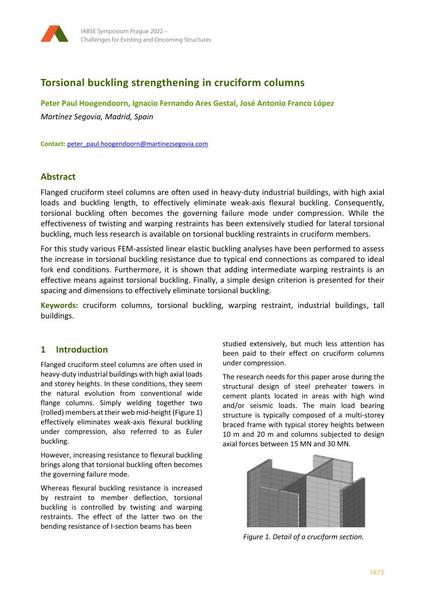Torsional buckling strengthening in cruciform columns

|
|
|||||||||||
Détails bibliographiques
| Auteur(s): |
Peter Paul Hoogendoorn
(Martínez Segovia, Madrid, Spain)
Ignacio Fernando Ares Gestal (Martínez Segovia, Madrid, Spain) José Antonio Franco López (Martínez Segovia, Madrid, Spain) |
||||
|---|---|---|---|---|---|
| Médium: | papier de conférence | ||||
| Langue(s): | anglais | ||||
| Conférence: | IABSE Symposium: Challenges for Existing and Oncoming Structures, Prague, Czech Republic, 25-27 May 2022 | ||||
| Publié dans: | IABSE Symposium Prague 2022 | ||||
|
|||||
| Page(s): | 1873-1881 | ||||
| Nombre total de pages (du PDF): | 9 | ||||
| DOI: | 10.2749/prague.2022.1873 | ||||
| Abstrait: |
Flanged cruciform steel columns are often used in heavy-duty industrial buildings, with high axial loads and buckling length, to effectively eliminate weak-axis flexural buckling. Consequently, torsional buckling often becomes the governing failure mode under compression. While the effectiveness of twisting and warping restraints has been extensively studied for lateral torsional buckling, much less research is available on torsional buckling restraints in cruciform members. For this study various FEM-assisted linear elastic buckling analyses have been performed to assess the increase in torsional buckling resistance due to typical end connections as compared to ideal fork end conditions. Furthermore, it is shown that adding intermediate warping restraints is an effective means against torsional buckling. Finally, a simple design criterion is presented for their spacing and dimensions to effectively eliminate torsional buckling. |
||||
| Mots-clé: |
bâtiments industriels
|
||||
| Copyright: | © 2022 International Association for Bridge and Structural Engineering (IABSE) | ||||
| License: | Cette oeuvre ne peut être utilisée sans la permission de l'auteur ou détenteur des droits. |
||||
